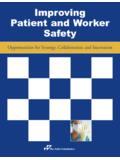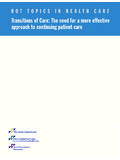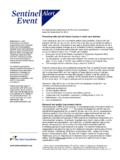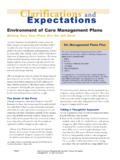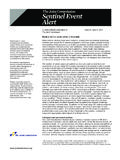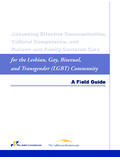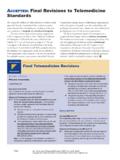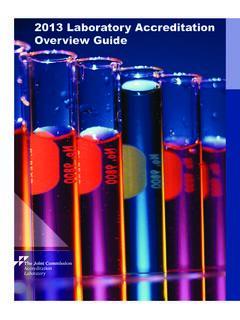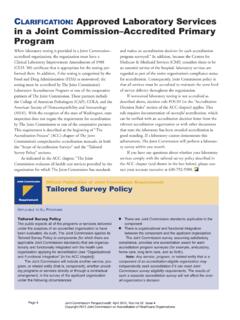Transcription of THE OFFICIAL NEWSLETTER OF THE JOINT ... - Joint …
1 April 2020 l Volume 40 | Number 4.. JOINT Commission Perspectives THE OFFICIAL NEWSLETTER OF THE JOINT COMMISSION. Contents 2 Video Message from Dr. Chassin on COVID-19 Pandemic JOINT Commission President and CEO, Dr. Mark Chassin, provides a video message supporting all health care organizations and frontline staff navigating the challenges of the COVID-19 crisis. 3 Full-Year 2019 Top Noncompliance Data A new format illustrates noncompliance data as they relate to the SAFER Matrix. 31 Implementation of Perinatal Safety Standards Delayed The JOINT Commission is delaying its implementation of two new perinatal safety standards to allow hospitals to focus on the current pandemic affecting health care worldwide.
2 32 FAQ: Clarifying Expectations for Suicide Risk Reduction in Nonpsychiatric Areas The JOINT Commission clarifies its expectation for environmental risk assessments in nonpsychiatric areas in general hospitals. 33 Update: Spring 2020 Postings to E-dition for Accreditation and Certification Manuals with March and July 2020 Requirements March interim requirements have posted to E-dition , with July requirements to post soon. 35 The JOINT Commission Releases Next Round of Heads-Up Reports First quarter Heads-Up Reports have released for all eight accreditation programs. 36 Consistent Interpretation 37 The JOINT Commission Journal on Quality and Patient Safety Table of Contents.
3 March 2020. 39 In Sight 1 Copyright 2020 The JOINT Commission JOINT Commission Perspectives , April 2020, Volume 40, Issue 4. Video Message from Dr. Chassin on COVID-19 Pandemic The JOINT Commission recognizes the incredible challenge that health care organizations and front-line workers are facing with the COVID-19 crisis. But while we have never seen anything like this, health care workers in the hardest hit areas are heroically working to save patients despite challenging conditions and shortages of personal protective equipment (PPE). The situation is changing rapidly, and recommendations have been changing with simi- lar speed.
4 We also understand that health care personnel are wading through a deluge of information. Therefore, we have created a resource page for health care professionals and organizations that provides only the information that best meets the needs of health care workers and leaders. We also will continue to update this library of internal and external resources for our customers and the public. If you have other questions, need other resources, or have leading practices you would like to share, please contact us. Our President & CEO, Dr. Mark Chassin, wants you to know that we are here for you. How- ever long it takes, you will have The JOINT Commission's full support.
5 See this short video for more information. [2:10] P. 2 Copyright 2020 The JOINT Commission JOINT Commission Perspectives , April 2020, Volume 40, Issue 4. Full-Year 2019 Top Noncompliance Data New Format Focuses on High-Risk Requirements The JOINT Commission regularly aggregates standards compliance data to identify areas that result in the highest number of Requirements for Improvement (RFIs) in accredited and certified programs. These data help The JOINT Commission recognize trends and tailor education around challenging standards and National Patient Safety Goals (NPSGs). Perspectives annually publishes the top 10 JOINT Commission requirements scored most frequently as not compliant during accreditation surveys performed in the previous year (for each program); in addition, it publishes these data on the first six months of the current year in a late summer issue.
6 In its efforts to provide organizations with the most relevant data to help them achieve zero harm, this year's lists have been revised to report on the top elements of performance (EPs) scored on the Survey Anal- ysis for Evaluating Risk (SAFER ) Matrix in 2019 in the higher-risk categories. Click this link to review the top 10 standards scored in 2019. SAFER Placement In January 2017 The JOINT Commission introduced the SAFER approach to cite deficiencies found and observed during on-site surveys. The implementation of the SAFER Matrix was driven by The JOINT Commis- sion's desire to provide its accredited and certified organizations with an on-site and post-survey experience that helps them focus on areas of noncompliance that are more likely to cause harm to patients, residents, and individuals served, staff, or visitors, or are more widespread in scope.
7 The 2019 standards noncompliance data will reflect only those RFIs placed in the moderate pattern through high widespread risk (and Immediate Threat to Health or Safety) categories. Because the SAFER. Matrix is now familiar to most accredited and certified health care organizations, depicting scoring patterns in these areas can help organizations focus resources and corrective action plans in areas that are most in need of compliance activities and interventions. In addition, these data are provided at the EP level, which allows health care organizations to see the specific components driving scoring at any particular standard.
8 Included Data The following bar charts show the top frequently scored standard/EP from January 1, 2019, through December 31, 2019, for each of the eight accreditation programs (certification information will be listed in a forthcoming issue of Perspectives). The colors in the bar charts depict where on the SAFER Matrix EPs were placed, and the numbers in the chart reflect the total number of surveys in 2019 with findings at that stan- dard/EP and in that risk category. After each chart is a table with the standard and EP text for easy reference (this table does not include notes, footnotes, references, or rationales).
9 In addition, this table includes the topic, key words, and in some cases common observations. For a comprehensive look at each standard, please refer to E-dition or the program-specific Comprehensive Accreditation Manual. Note that surveyors evaluate compliance with all standards in the accreditation manuals. These data are provided only to help organizations recognize and address potential trouble spots. Health care organizations also can view the most frequently scored standards, as they have been depicted previously at the standard (not EP) level. Visit the JOINT Commission Standards FAQs page for questions and answers regarding JOINT Commission requirements; questions not addressed in the FAQs may be directed to the Standards Interpretation Group via the Standards Online Submission Form.
10 P. 3 Copyright 2020 The JOINT Commission JOINT Commission Perspectives , April 2020, Volume 40, Issue 4. 2019 Most Frequently Scored Higher-Risk* Accreditation Requirements . Scored from January 1 through December 31, 2019. Ambulatory Health Care Standard EP Keywords/Topics : The organization reduces the EP 2: The organization implements infec- l Intermediate and high-level disinfection risk of infections associated with medical tion prevention and control activities when and sterilization equipment, devices, and supplies. doing the following: Performing intermedi- l Disinfection, infection prevention ate and high-level disinfection and steriliza- l Instrument processing tion of medical equipment, devices, and l Following manufacturers' instructions supplies.
